WPF拖动总结
WPF拖动总结
这篇博文总结下WPF中的拖动,文章内容主要包括:
1.拖动窗口
2.拖动控件 Using Visual Studio
2.1thumb控件
2.2Drag、Drop(不连续,没有中间动画)
2.3拖动一个控件
2.4让一个窗口内的所有(指定的)控件可拖动
3.Expression Blend X实现拖动(Best Practice)
小结
1.拖动窗口
我们知道,鼠标放在窗口的标题栏上按下就可以拖动窗体。我们要实现在窗口的全部地方或特定地方按下鼠标左键实现拖动。
Winform的做法是,获取鼠标的位置信息,从而设置窗体的位置。
WPF也可以采用Winform类似的方法,但是没有必要,因为有更加单的方法。
<Window x:Class="WpfApplicationDrugMove.MainWindow" xmlns="http://schemas.microsoft.com/winfx/2006/xaml/presentation" xmlns:x="http://schemas.microsoft.com/winfx/2006/xaml" Title="窗体拖动" Height="350" Width="525"> <Grid Background="Green" MouseLeftButtonDown="Grid_MouseLeftButtonDown"> <Canvas Height="65" Background="Gray" HorizontalAlignment="Left" Margin="284,110,0,0" Name="canvas1" VerticalAlignment="Top" Width="74" MouseLeftButtonDown="canvas1_MouseLeftButtonDown"> </Canvas> </Grid> </Window>
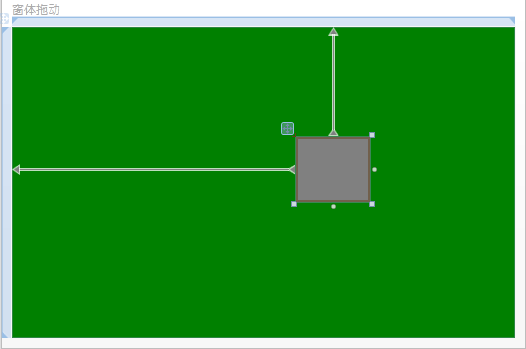
有Grid布局的窗口,里面放置了一个Canvas。
要实现在Grid内按下鼠标左键实现窗体拖动/或是Canvas内实现按下鼠标左键实现窗体拖动,代码如下:
private void canvas1_MouseLeftButtonDown(object sender, MouseButtonEventArgs e) { base.DragMove();//实现整个窗口的拖动 } private void Grid_MouseLeftButtonDown(object sender, MouseButtonEventArgs e) { base.DragMove(); }
从上面的代码我们可以看到,DragMove()方法仅用来实现窗体的拖动。
2.拖动控件
2.1thumb控件
thumb控件MSDN的描述非常简单:Represents a control that can be dragged by the user.(表示可由用户拖动的控件)。
由DragStarted、DragDelta、DragCompleted着三个事件完成控件的拖动。
给个例子:我们在Canvas中加入如下thumb控件
<Thumb Name="thumb1" Background="Red" Height="50" Width="100" DragDelta="DragDelta" DragStarted="DragStarted" DragCompleted="DragCompleted" Canvas.Left="335" Canvas.Top="121" />
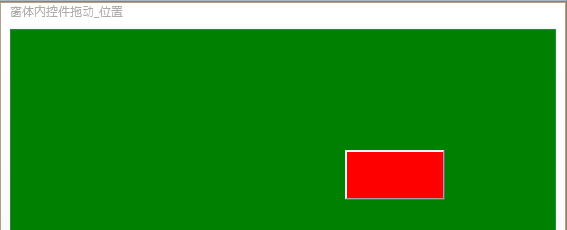
实现相应的事件,即可完成该控件的拖动工作。
private void DragDelta(object sender, System.Windows.Controls.Primitives.DragDeltaEventArgs e) { Canvas.SetLeft(thumb1,Canvas.GetLeft(thumb1)+e.HorizontalChange); Canvas.SetTop(thumb1, Canvas.GetTop(thumb1) + e.VerticalChange); } private void DragStarted(object sender, System.Windows.Controls.Primitives.DragStartedEventArgs e) { thumb1.Background = Brushes.White; } private void DragCompleted(object sender, System.Windows.Controls.Primitives.DragCompletedEventArgs e) { thumb1.Background = Brushes.Red; }
这只是一个简单的示例,我们知道thumb有拇指的意思,代表着很棒的意思。
在2008-08-23在codeproject上发表的WPF Diagram Designer(WPF图形设计器)系列文章(共3篇),被国内很多人Copy过来说是他自己弄的(吐槽:这里省去3K字),其中关于thumb的运用可供参考,thumb可以实现控件的拖动。
2.2 drag、drop(不连续,没有中间动画)
很多控件都有AllowDrop属性:允许放下;和Drop事件。
给出两个例子。
例1:
<Grid> <Label Name ="label1" Content="TestDrop" Background="Red" Height ="28" HorizontalAlignment="Left" Margin="70,35,0,0" VerticalAlignment="Top" MouseDown="label1_MouseDown" /> <Label Name="label2" Content="ToHere" Background="Green" Height="28" HorizontalAlignment="Left" Margin ="342,107,0,0" VerticalAlignment="Top" AllowDrop ="True" Drop="tagert_drop" /> </Grid>
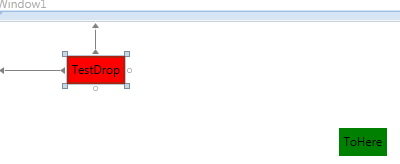
现在,拖拽label1到label上,把label1的text赋值给label2.实现如下:
private void label1_MouseDown(object sender, MouseButtonEventArgs e) { Label lbl = (Label)sender; DragDrop.DoDragDrop(lbl, lbl.Content, DragDropEffects.Copy); } private void tagert_drop(object sender, DragEventArgs e) { ((Label)sender).Content = e.Data.GetData(DataFormats.Text); }
例2:
界面上有两个Canvas,右面的Canvas里面有一个Rectangle。拖动右面的Rectangle把它拖到左边来,并且保留右边的Rectangle。
<Window x:Class="WpfApplicationDrugMove.Windowdragdrop" xmlns="http://schemas.microsoft.com/winfx/2006/xaml/presentation" xmlns:x="http://schemas.microsoft.com/winfx/2006/xaml" Title="Windowdragdrop" Height="369" Width="559"> <Grid> <Canvas Background="ForestGreen" Height="282" HorizontalAlignment="Left" Margin="22,20,0,0" Name="canvas1" VerticalAlignment="Top" Width="226" /> <Canvas Background="ForestGreen" Height="282" HorizontalAlignment="Left" Margin="278,20,0,0" Name="canvas2" VerticalAlignment="Top" Width="232"> <Rectangle Fill="Yellow" Canvas.Left="35" Canvas.Top="36" Height="100" Name="rectangle1" Stroke="Black" Width="150" /> </Canvas> </Grid> </Window>
namespace WpfApplicationDrugMove { /// <summary> /// Interaction logic for Windowdragdrop.xaml /// </summary> public partial class Windowdragdrop : Window { public Windowdragdrop() { InitializeComponent(); canvas1.AllowDrop = true; rectangle1.PreviewMouseMove += new MouseEventHandler(rectangle1_PreviewMouseMove); canvas1.DragOver += new DragEventHandler(canvas1_DragOver); canvas1.Drop += new DragEventHandler(canvas1_Drop); } void rectangle1_PreviewMouseMove(object sender, MouseEventArgs e) { if (e.LeftButton == MouseButtonState.Pressed) { DataObject data = new DataObject(typeof(Rectangle), rectangle1); DragDrop.DoDragDrop(rectangle1, data, DragDropEffects.Copy); } } void canvas1_Drop(object sender, DragEventArgs e) { IDataObject data = new DataObject(); data = e.Data; if (data.GetDataPresent(typeof(Rectangle))) { Rectangle rect = new Rectangle(); rect = data.GetData(typeof(Rectangle)) as Rectangle; //canvas2.Children.Remove(rect); //canvas1.Children.Add(rect); //序列化Control,以深复制Control!!!! string rectXaml = XamlWriter.Save(rect); StringReader stringReader = new StringReader(rectXaml); XmlReader xmlReader = XmlReader.Create(stringReader); UIElement clonedChild = (UIElement)XamlReader.Load(xmlReader); canvas1.Children.Add(clonedChild); } } void canvas1_DragOver(object sender, DragEventArgs e) { if(!e.Data.GetDataPresent(typeof(Rectangle))) { e.Effects = DragDropEffects.None; e.Handled = true; } } } }
效果如下: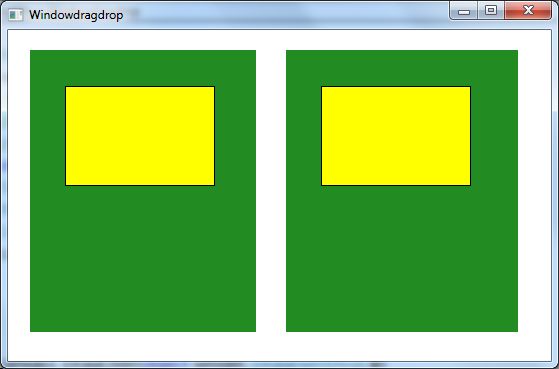
这个也就回答了博客园的一篇博问:WPF拖拽实现
虽然这个问题被标记为解决,但是其解决的方法过于丑陋,具体请看DebugLZQ本文代码实现。
2.3拖动一个控件
实现和thumb一样的效果,不同于drag/drop,拖动的时候控件跟随鼠标移动。
<Canvas x:Name="canvas1" Background="Green"> <Canvas Background="Yellow" Canvas.Left="85" Canvas.Top="51" Height="100" Name="canvas2" Width="105" MouseLeftButtonDown="canvas2_MouseDown" MouseMove="canvas2_MouseMove" MouseLeftButtonUp="canvas2_MouseLeftButtonUp"></Canvas> </Canvas>

Canvas中又一个控件(Canvas2),实现canvas2的拖动。
实现canvas2的MouseLeftButtonDown、MouseMove、MouseLeftButtonUp事件。
Point oldPoint = new Point(); bool isMove = false; private void canvas2_MouseMove(object sender, MouseEventArgs e) { if (isMove) { canvas2.Background = Brushes.White; FrameworkElement currEle = sender as FrameworkElement; double xPos = e.GetPosition(null).X - oldPoint.X + (double)currEle.GetValue(Canvas.LeftProperty); double yPos = e.GetPosition(null).Y - oldPoint.Y + (double)currEle.GetValue(Canvas.TopProperty); currEle.SetValue(Canvas.LeftProperty, xPos); currEle.SetValue(Canvas.TopProperty, yPos); oldPoint = e.GetPosition(null); } } private void canvas2_MouseDown(object sender, MouseButtonEventArgs e) { isMove = true; oldPoint = e.GetPosition(null); } private void canvas2_MouseLeftButtonUp(object sender, MouseButtonEventArgs e) { isMove = false; canvas2.Background = Brushes.Yellow; }
2.4让一个窗口内的所有(指定的)控件可拖动
有2.3的基础,现在我们就可以很方便的实现容器内所有控件拖动了。不仅仅局限于Canvas。其实Canvas的绝对定位和其他的容器(如Grid)没多好差别,只不过Canvas使用Left/Top来定位;Grid是用Margin,仅此而已!
1.还是Canvas中的拖动
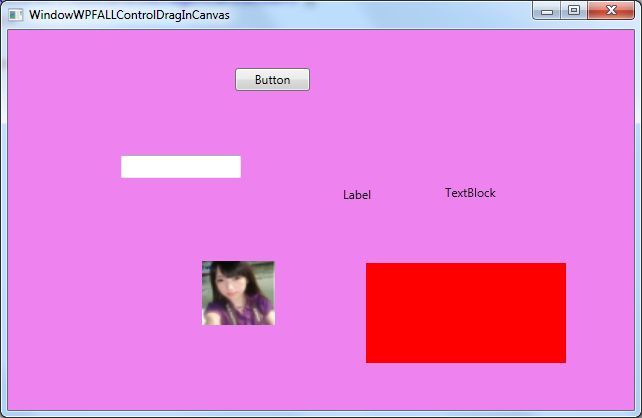
<Window x:Class="WpfApplicationDrugMove.WindowWPFALLControlDragInCanvas" xmlns="http://schemas.microsoft.com/winfx/2006/xaml/presentation" xmlns:x="http://schemas.microsoft.com/winfx/2006/xaml" Title="WindowWPFALLControlDragInCanvas" Height="418" Width="642"> <Canvas x:Name="LayoutRoot" Background="Violet"> <Label Canvas.Left="330" Canvas.Top="151" Content="Label" Height="28" Name="label1" /> <TextBlock Canvas.Left="437" Canvas.Top="154" Height="23" Name="textBlock1" Text="TextBlock" /> <Image Canvas.Left="206" Canvas.Top="231" Height="64" Name="image1" Stretch="Fill" Width="73" Source="/WpfApplicationDrugMove;component/1.jpg" /> <Canvas Canvas.Left="358" Canvas.Top="233" Height="100" Name="canvas1" Width="200" Background="Red"></Canvas> <Button Canvas.Left="227" Canvas.Top="38" Content="Button" Height="23" Name="button1" Width="75" /> <TextBox Canvas.Left="113" Canvas.Top="125" Height="23" Name="textBox1" Width="120" /> </Canvas> </Window>
using System; using System.Collections.Generic; using System.Linq; using System.Text; using System.Windows; using System.Windows.Controls; using System.Windows.Data; using System.Windows.Documents; using System.Windows.Input; using System.Windows.Media; using System.Windows.Media.Imaging; using System.Windows.Shapes; namespace WpfApplicationDrugMove { /// <summary> /// Interaction logic for WindowWPFALLControlDrag.xaml /// </summary> public partial class WindowWPFALLControlDragInCanvas:Window { public WindowWPFALLControlDragInCanvas() { InitializeComponent(); foreach (UIElement uiEle in LayoutRoot.Children) { //WPF设计上的问题,Button.Clicked事件Supress掉了Mouse.MouseLeftButtonDown附加事件等. //不加这个Button、TextBox等无法拖动 if (uiEle is Button||uiEle is TextBox) { uiEle.AddHandler(Button.MouseLeftButtonDownEvent, new MouseButtonEventHandler(Element_MouseLeftButtonDown), true); uiEle.AddHandler(Button.MouseMoveEvent, new MouseEventHandler(Element_MouseMove),true); uiEle.AddHandler(Button.MouseLeftButtonUpEvent, new MouseButtonEventHandler(Element_MouseLeftButtonUp), true); continue; } // uiEle.MouseMove += new MouseEventHandler(Element_MouseMove); uiEle.MouseLeftButtonDown += new MouseButtonEventHandler(Element_MouseLeftButtonDown); uiEle.MouseLeftButtonUp += new MouseButtonEventHandler(Element_MouseLeftButtonUp); } } bool isDragDropInEffect = false; Point pos = new Point(); void Element_MouseMove(object sender, MouseEventArgs e) { if (isDragDropInEffect) { FrameworkElement currEle = sender as FrameworkElement; double xPos = e.GetPosition(null).X - pos.X + (double)currEle.GetValue(Canvas.LeftProperty); double yPos = e.GetPosition(null).Y - pos.Y + (double)currEle.GetValue(Canvas.TopProperty); currEle.SetValue(Canvas.LeftProperty, xPos); currEle.SetValue(Canvas.TopProperty, yPos); pos = e.GetPosition(null); } } void Element_MouseLeftButtonDown(object sender, MouseButtonEventArgs e) { FrameworkElement fEle = sender as FrameworkElement; isDragDropInEffect = true; pos = e.GetPosition(null); fEle.CaptureMouse(); fEle.Cursor = Cursors.Hand; } void Element_MouseLeftButtonUp(object sender, MouseButtonEventArgs e) { if (isDragDropInEffect) { FrameworkElement ele = sender as FrameworkElement; isDragDropInEffect = false; ele.ReleaseMouseCapture(); } } } }
注意:需要用AddHandler添加Button.MouseLeftButtonDown等事件,不然无法触发,因为Button.Clicked事件Supress掉了MouseLeftButtonDown。
这样页面上的所有控件就可以随意拖动了。
今天在CodeProject上看到了这篇文章:WPF - Catch Events Even if they are Already Handled,说的是一个事情。
2.Canvas换成Grid。Grid中所有控件可拖动。
<Window x:Class="WpfApplicationDrugMove.WindowWPFALLControlDragMoveInGrid" xmlns="http://schemas.microsoft.com/winfx/2006/xaml/presentation" xmlns:x="http://schemas.microsoft.com/winfx/2006/xaml" Title="WindowWPFALLControlDragMoveInGrid" Height="382" Width="552"> <Grid x:Name="LayoutRoot" Background="GreenYellow"> <Button Content="Button" Height="23" HorizontalAlignment="Left" Margin="60,42,0,0" Name="button1" VerticalAlignment="Top" Width="75" /> <Label Content="Label" Height="28" HorizontalAlignment="Left" Margin="305,89,0,0" Name="label1" VerticalAlignment="Top" /> <Button Content="Button" Height="23" HorizontalAlignment="Left" Margin="204,45,0,0" Name="button2" VerticalAlignment="Top" Width="75" /> <TextBlock Height="23" HorizontalAlignment="Left" Margin="363,42,0,0" Name="textBlock1" Text="TextBlock" VerticalAlignment="Top" /> <TextBox Height="23" HorizontalAlignment="Left" Margin="60,140,0,0" Name="textBox1" VerticalAlignment="Top" Width="120" /> <Image Height="56" HorizontalAlignment="Left" Margin="173,229,0,0" Name="image1" Stretch="Fill" VerticalAlignment="Top" Width="62" Source="/WpfApplicationDrugMove;component/1.jpg" /> <Image Height="150" HorizontalAlignment="Left" Margin="291,159,0,0" Name="image2" Stretch="Fill" VerticalAlignment="Top" Width="177" Source="/WpfApplicationDrugMove;component/2.gif" /> </Grid> </Window>
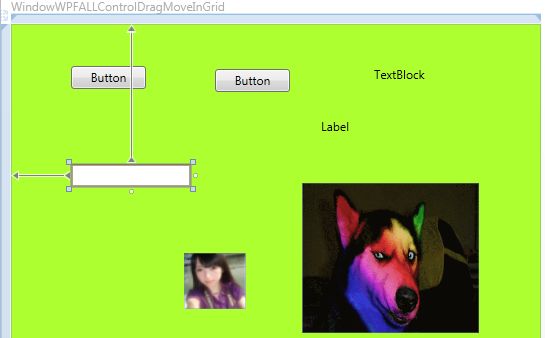
using System; using System.Collections.Generic; using System.Linq; using System.Text; using System.Windows; using System.Windows.Controls; using System.Windows.Data; using System.Windows.Documents; using System.Windows.Input; using System.Windows.Media; using System.Windows.Media.Imaging; using System.Windows.Shapes; namespace WpfApplicationDrugMove { /// <summary> /// Interaction logic for WindowWPFALLControlDragMoveInGrid.xaml /// </summary> public partial class WindowWPFALLControlDragMoveInGrid : Window { public WindowWPFALLControlDragMoveInGrid() { InitializeComponent(); foreach (UIElement uiEle in LayoutRoot.Children) { if (uiEle is Button || uiEle is TextBox) { uiEle.AddHandler(Button.MouseLeftButtonDownEvent, new MouseButtonEventHandler(Element_MouseLeftButtonDown), true); uiEle.AddHandler(Button.MouseMoveEvent, new MouseEventHandler(Element_MouseMove), true); uiEle.AddHandler(Button.MouseLeftButtonUpEvent, new MouseButtonEventHandler(Element_MouseLeftButtonUp), true); continue; } uiEle.MouseMove += new MouseEventHandler(Element_MouseMove); uiEle.MouseLeftButtonDown += new MouseButtonEventHandler(Element_MouseLeftButtonDown); uiEle.MouseLeftButtonUp += new MouseButtonEventHandler(Element_MouseLeftButtonUp); } } bool isDragDropInEffect = false; Point pos = new Point(); void Element_MouseMove(object sender, MouseEventArgs e) { if (isDragDropInEffect) { FrameworkElement currEle = sender as FrameworkElement; double xPos = e.GetPosition(null).X - pos.X + currEle.Margin.Left; double yPos = e.GetPosition(null).Y - pos.Y + currEle.Margin.Top; currEle.Margin = new Thickness(xPos, yPos, 0, 0); pos = e.GetPosition(null); } } void Element_MouseLeftButtonDown(object sender, MouseButtonEventArgs e) { FrameworkElement fEle = sender as FrameworkElement; isDragDropInEffect = true; pos = e.GetPosition(null); fEle.CaptureMouse(); fEle.Cursor = Cursors.Hand; } void Element_MouseLeftButtonUp(object sender, MouseButtonEventArgs e) { if (isDragDropInEffect) { FrameworkElement ele = sender as FrameworkElement; isDragDropInEffect = false; ele.ReleaseMouseCapture(); } } } }
效果如下: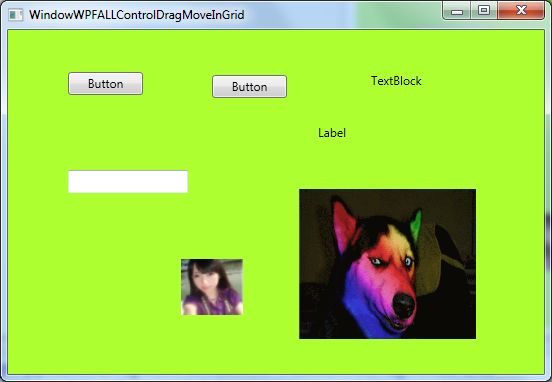
Grid界面中的所有控件可随意拖动。
3.使用Expression Blend实现拖动(Best Practice)
使用如下的一个Behavior:MouseDragElementBehavior
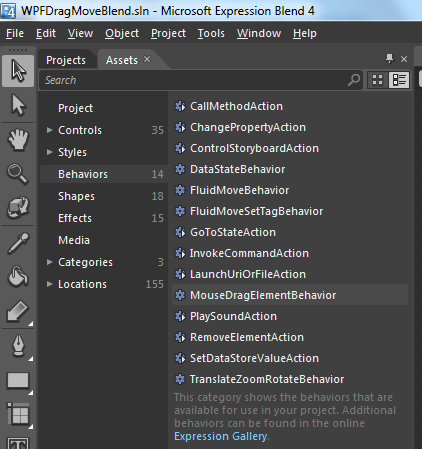
实现方法非常简单,let's say 我们有个Rectangle,无论在什么容器中,我们要实现其拖动。
直接把这个MouseDragElementBehavior 拖动到Rectangle中即可。
XAML如下:
<Window xmlns="http://schemas.microsoft.com/winfx/2006/xaml/presentation" xmlns:x="http://schemas.microsoft.com/winfx/2006/xaml" xmlns:i="http://schemas.microsoft.com/expression/2010/interactivity" xmlns:ei="http://schemas.microsoft.com/expression/2010/interactions" x:Class="WPFDragMoveBlend.MainWindow" Title="MainWindow" Height="350" Width="525"> <Grid> <Rectangle Fill="Red" Stroke="Black" Margin="145,82,164,50" Width="200" Height="180" > <i:Interaction.Behaviors> <ei:MouseDragElementBehavior/> </i:Interaction.Behaviors> </Rectangle> </Grid> </Window>
(如您所见,DebugLZQ使用的是 Expression Blend 4)。
程序运行正常,Rectangle可随意拖动如下:
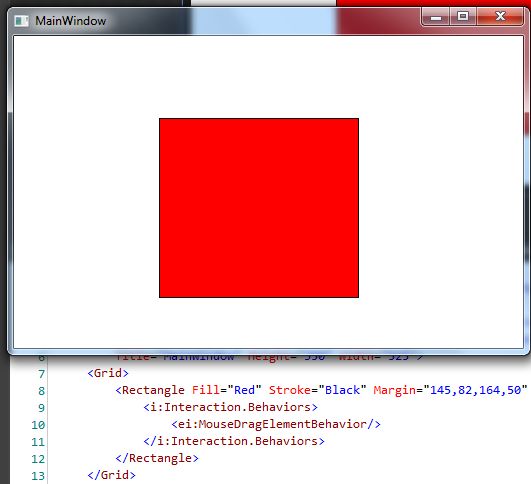
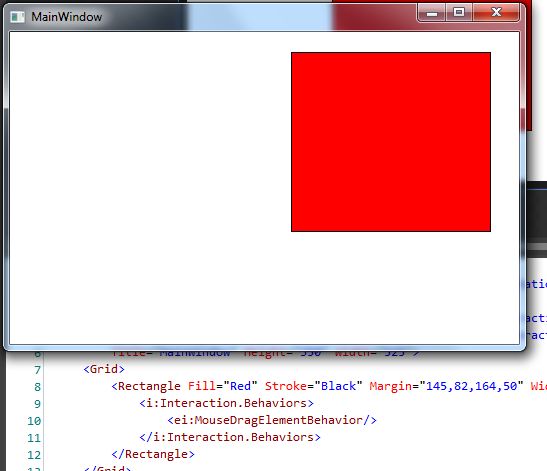
使用Blend借助Behaviors不需要额外的C#代码,最为简洁。
其他的一些Behaviors也非常有用,
如播放MP3:
<Window xmlns="http://schemas.microsoft.com/winfx/2006/xaml/presentation" xmlns:x="http://schemas.microsoft.com/winfx/2006/xaml" xmlns:i="http://schemas.microsoft.com/expression/2010/interactivity" xmlns:ei="http://schemas.microsoft.com/expression/2010/interactions" x:Class="WPFDragMoveBlend.MainWindow" Title="MainWindow" Height="350" Width="525"> <Grid> <Rectangle Fill="Red" Stroke="Black" Margin="145,82,164,50" Width="200" Height="180" > <i:Interaction.Triggers> <i:EventTrigger EventName="MouseLeftButtonDown"> <ei:PlaySoundAction Source="C:\Users\Public\Music\Sample Music\Kalimba.mp3"/> </i:EventTrigger> </i:Interaction.Triggers> <i:Interaction.Behaviors> <ei:MouseDragElementBehavior/> </i:Interaction.Behaviors> </Rectangle> </Grid> </Window>
程序可正常运行。
还有如CallMethodAction,ControlStoryboardAction,及MVVM中使用较多的InvokeCommandAction等。
小结一下:
关于2.2例2中控件的序列化、反序列化! 参考:WPF控件深拷贝:序列化/反序列化
关于Button.MouseLeftButtonDown用C#代码注册的话需要用AddHandler添加,直接添加会被Button.Clicked阻止! 另一种情况是:我们如何捕获一个路由事件,即使这个路由事件已经被标记为e.handled=true。这个很重要!!!参考:WPF捕获事件即使这个事件被标记为Handled 。拖动不局限于Canvas.
所有方法中,Blend实现最为Clearn.关于Blend 4的快捷键,请参考:A Complete Guide to Expression Blend 4 Shortcut Keys
老鸟绕过,轻拍~
Wish it helps.
